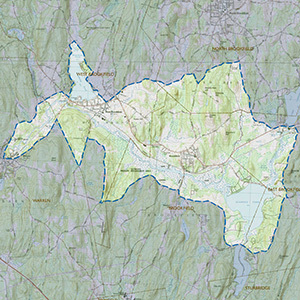Important Bird Area Sites in Massachusetts
Important Bird Area: Quaboag
Site Summary
Nominated By
John Liller, Mark Lynch, Sheila Carroll
Size
3,086 acres
Towns and Counties
Brookfield, North Brookfield, Warren, West Brookfield; Worcester
Ownership
MassWildlife, Mass Audubon
Major Habitats
oak-conifer forest, cultural grassland, cultivated field, emergent freshwater wetland, shrub-scrub wetland
Land Use
nature & wildlife, hunting & fishing, other recreation or tourism, suburban-residential
Serious Threats
non-native invasive plants, habitat conversion, residential development
Minor Threats
recreation development and overuse
IBA Criteria
- Category 1: Sites important for long-term research and/or monitoring projects that contribute substantially to ornithology, bird conservation, and/or education.
- Category 4: Sites containing assemblages of species characteristic of a representative, rare, threatened, or unique habitat within the state or region.
- Category 5: Waterfowl: The site regularly supports 500 or more waterfowl at any one time. The designation "waterfowl" includes birds such as loons, grebes, cormorants, geese, ducks, coots, and moorhens.
Site Description
The Quaboag IBA consists of three wildlife management areas (Quaboag, Richardson, and Quacumquasit); a Mass Audubon Wildlife Sanctuary (Elm Hill); two large ponds (Quaboag and Wickaboag); and a stretch along the Quaboag River, that contains Worcester County's most extensive cattail marshes. This IBA contains critical, extensive, freshwater marsh habitat for a cadre of marsh species and migrant waterfowl. The two large lakes are extensively used by numerous migrating waterfowl as well as loons and grebes. The surrounding wooded areas bordering the river host numbers of species that are rapidly dwindling in this part of Massachusetts as it is overdeveloped. Finally, farmland, rapidly vanishing in these parts, contains breeding habitat for a number of grassland species. Taken as a single unit of adjacent river, lakes, marshlands, forests, and farmland, the Quaboag IBA is a prime piece of Massachusetts natural habitat that is fast disappearing.
Current Conservation Status
Development of forest and farmland in this part of Massachusetts is occurring at a frightening pace. This formally quiet area of the West and North Brookfield-with farms, ponds, rivers and extensive woodlots-is on the brink of changing forever. Fortunately, both MassWildlife and Mass Audubon have preserved large parcels of land. The areas between these parcels are threatened. A very real concern to the many acres of cattail marshes is the invasion of Purple Loosestrife. Recreational use (hunting, fishing, pleasure boating) interferes with migrant waterfowl on the two lakes (Quaboag and Wickaboag) but at a level that can so far tolerated.
Ornithological Significance
Extensive mature mixed forest in the Quaboag and Richardson Wildlife Management Areas host many breeding species of warblers normally found in places like Quabbin as well as breeding Barred and Northern Saw-whet Owls. Extensive farmland contained within the IBA, particularly at Elm Hill, host a good number of grassland breeding species such as the Bobolink, Eastern Meadowlark, and Savannah Sparrow. The cattail marshes along the Quaboag River and its tributaries host the county's largest colony of Marsh Wrens, many rails, and good numbers of American Bitterns, as well as recent breeding-period records of Least Bitterns and Common Moorhens.
Other Species: Common Loon, Red-necked Grebe, Great Cormorant, Cattle Egret, Brant, Tundra Swan, Wood Duck, Green-winged Teal, Redhead, Ring-necked Duck, Greater Scaup, White-winged Scoter, Black Scoter, Long-tailed Duck, Bufflehead, Common Goldeneye, Barrow's Goldeneye, Hooded Merganser, Common Merganser, Ruddy Duck, Osprey, Mississippi Kite, Broad-winged Hawk, Virginia Rail, Sora, American Coot, Greater Yellowlegs, Upland Sandpiper, Hudsonian Godwit, Pectoral Sandpiper, Iceland Gull, Lesser Black-backed Gull, Barn Owl, Common Nighthawk, Whip-poor-will, Eastern Phoebe, Alder Flycatcher, Willow Flycatcher, Eastern Kingbird, Red-eyed Vireo, Tree Swallow, Sedge Wren, Marsh Wren, Ruby-crowned Kinglet, Blue-Gray Gnatcatcher, Veery, Wood Thrush, Gray Catbird, Bohemian Waxwing, Blue-winged Warbler, Golden-winged Warbler, Chestnut-sided Warbler, Black-and-white Warbler, Ovenbird, Summer Tanager, Clay-colored Sparrow, Nelson's Sharp-tailed Sparrow, White-throated Sparrow, Lapland Longspur, Bobolink, Orchard Oriole, Purple Finch, Green Heron, Canada Goose, Mallard, American Black Duck, Ring-necked Duck, Hooded Merganser, Ruddy Duck, Rough-legged Hawk, Red-headed Woodpecker, Pine Siskin, Blue-headed Vireo. Breeding warblers: Blue-winged, Golder-winged, Nashville, Yellow, Chestnut-sided, Yellow-rumped, Black-throated Green, Blackburnian, Pine, Black and white; American Redstart, Ovenbird, Common Yellowthroat
Other Flora or Fauna of Significance
The Quaboag IBA contains habitat for a wide variety of vertebrates including species like the Fisher and Northen Otter. A recently discovered disjunct population of Black Rate Snake has been found in the Wells State Park and documented by MassWildlife. Inventory of invertebrate species has only just begun, but species such as the Bronze Copper have been found. The globally rare Long's Bulrush was discovered along the banks of the Quaboag River in 2000.
Data Sources
See The Chickadee and Bird Observer.




